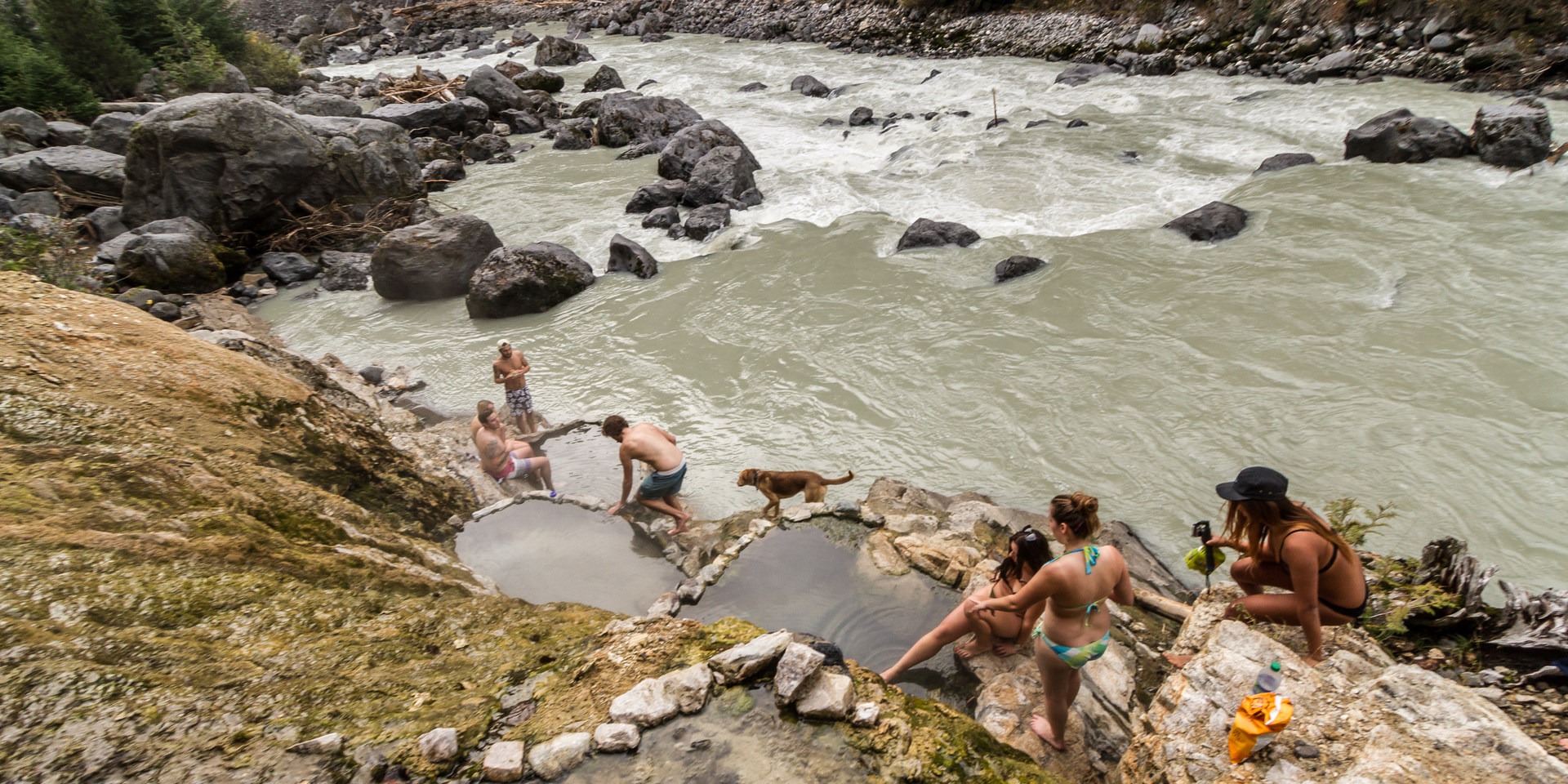You are here
Keyhole Hot Springs, also known as Pebble Creek Hot Springs, is a beautiful, rugged, and geographically fascinating place. The springs are located about an hour’s drive northwest of Pemberton and sit in the shadow of Mount Meager just a kilometer or so downstream from the incredible Keyhole Falls. The area is quite remote, and for many years the hot springs were rarely busy. There are currently two hydroelectric dams under construction in the area, however, and a new and more obviously marked trail has recently been built to get to the springs, which has led to an increase in traffic. If there is a silver lining, it’s that the gravel road leading to the trailhead is in much better shape than it used to be, and it is now easily passable in any vehicle.
The area surrounding Mount Meager is known to be one of the most geologically unstable regions in North America, and it produced the largest volcanic eruption in Canada in the last 10,000 years. It happened just 2,400 years ago, and it was similar in strength to that of the 1980 eruption of Mount St. Helens in Washington State. Keyhole and nearby Meager Creek Hot Springs are evidence of volcanism in the area. The hot springs at Meager Creek were once accessible from the Lillooet North forest service road, but bridge washouts in 1998, 2003, and 2009 meant that the site was closed more often than not, and they eventually gave up on rebuilding the two bridges. This turned out to be a wise decision as both would have been completely destroyed by the massive landslide of 2010. A new trail to Meager Hot Springs was opened in 2015, and it eliminates the need for bridges by starting on the south side of the Lillooet River. A night of heavy rain in September 2015 led to several washouts on the forest service road that accesses the new trailhead, leaving campers and their vehicles stranded and rendering the hot springs inaccessible once again (current status is unknown).
While access to Meager Hot Springs has been inconsistent over the last decade, Keyhole Hot Springs has remained open. The only exceptions were for the temporary burial of the road by the 2010 landslide, which was Canada's largest, and for the 2015 wildfire. The only two comparable events are the Hope Slide of 1965 that killed five people and the Frank Slide of 1903 that buried an entire town and killed up to 90. The road to keyhole passes through the debris field at around the 36 kilometer mark. The 15-foot-tall walls along the sides of the road are impressive on their own, but you really need to spend some time walking around in the gigantic piles of rock, silt, mud, and crushed trees to fully comprehend the magnitude of the landslide. This raging torrent traveled over 10 kilometers from a sub-peak of Mount Meager, temporarily damming the Lillooet River with a 2-kilometer-wide barrier and creating a 1.5-kilometer-long lake. Overnight evacuation orders for Pemberton and Mount Currie were issued due to risk of a flash flood (the river eventually cut a channel through the debris and flood risk subsided). Miraculously, no one was hurt in the slide, but again there were some campers who narrowly avoided burial and ended up stranded behind mountains of debris.
In addition to the geological instability and volcanic activity, the area was also the site of a large wildfire during of 2015. Over 6,700 hectares burned over almost three months, and the resulting smoke spread all around the Pacific Northwest. As with the landslide, the road to Keyhole passes through the affected area, and it’s impossible to comprehend the magnitude of the fire until you are in the middle of it and staring at entire mountainsides covered with charred stumps.
The new trailhead is located at a pullout 42 kilometers down the Lillooet North forest service road. The Lillooet River Trail briefly passes through the dam construction site before descending to the river where it heads upstream for about 2 kilometers to Keyhole Hot Springs. The trail has some ups and downs and should take between 30 to 45 minutes at a moderate pace. The maintained trail ends after crossing a large wooden bridge over a creek. This is the area where most people camp. To get to the hot springs, continue through the flat forested area until you see a trail heading down toward the river on a log with stairs cut into it. The trail emerges on the riverbank next to a couple of small and shallow hot pools. You'll find a sandy area with hot water flowing across it where you can dig your own pool or just sink your feet into the warm sand. The three main pools are just upstream, built out of rocks and mortar on a steep and rocky embankment beside some fast-moving whitewater on the Lillooet River. The top pool is the hottest, and the lowest pool sometimes mixes with the cold river, depending on water levels. These hot springs are not as comfortable or spacious as some others, but the setting is spectacular and the journey to get here is thoroughly interesting as well. This place is worth the trek.
Logistics + Planning
Current Weather: Powered by Dark Sky
























Comments
Sign In and share them.